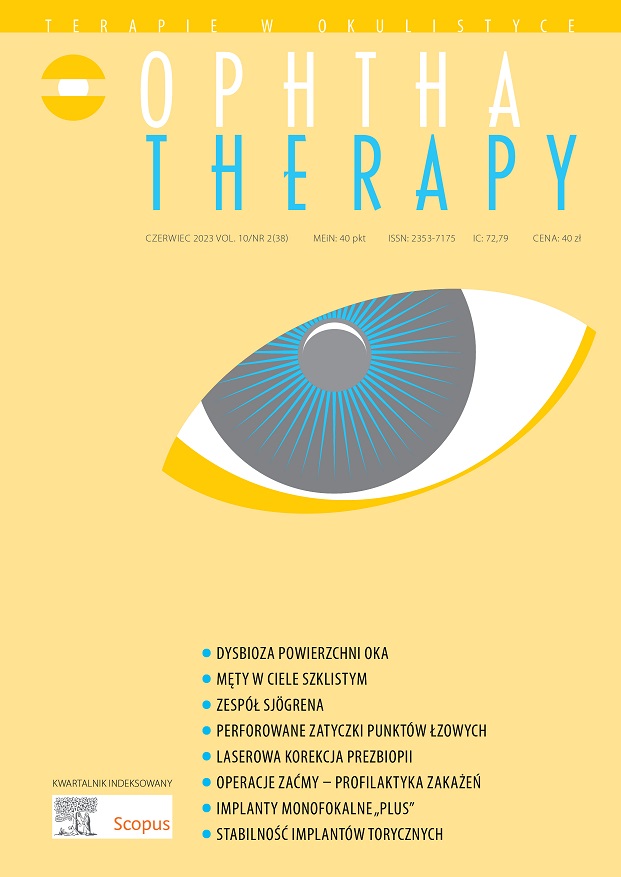Dysbiosis of the ocular surface – a new risk factor for ophthalmic diseases? The role of eyelid hygiene Review article
Main Article Content
Abstract
Quantitative and qualitative disturbances in the composition of the ocular surface microbiome can be a significant risk factor for the development of various ophthalmic disorders, including eyelid inflammation, dry eye syndrome, and allergic conjunctivitis. In this publication, we present a review of the data regarding the association between dysbiosis and these mentioned clinical conditions. Additionally, we provide recommendations for the treatment of dysbiosis, including eyelid hygiene.
Downloads
Article Details

This work is licensed under a Creative Commons Attribution-NonCommercial-NoDerivatives 4.0 International License.
Copyright: © Medical Education sp. z o.o. License allowing third parties to copy and redistribute the material in any medium or format and to remix, transform, and build upon the material, provided the original work is properly cited and states its license.
Address reprint requests to: Medical Education, Marcin Kuźma (marcin.kuzma@mededu.pl)
References
2. DeGruttola AK, Low D, Mizoguchi A et al. Current Understanding of Dysbiosis in Disease in Human and Animal Models. Inflamm is. 2016; 22(5): 1137-50. http://doi.org/10.1097/MIB.0000000000000750.
3. Xue W, Li JJ, Zou Y et al. Microbiota and Ocular Diseases. Front Cell Infect Microbiol. 2021; 11: 759333. http://doi.org/10.3389/fcimb.2021.759333.
4. Xu S, Zhang H. Bacteriological profile of conjunctiva bacterial Flora in Northeast China: a hospital based study. BMC Ophthalmol. 2022; 22(1): 223. http://doi.org/10.1186/s12886-022-02441-8.
5. Shivaji S, Jayasudha R, Sai Prashanthi G et al. The Human Ocular Surface Fungal Microbiome. Invest Ophthalmol Vis Sci. 2019; 60(1): 451-9. http://doi.org/10.1167/iovs.18-26076.
6. Doan T, Akileswaran L, Andersen D et al. Paucibacterial Microbiome and Resident DNA Virome of the Healthy Conjunctiva. Invest Ophthalmol Vis Sci. 2016; 57(13): 5116-26. http://doi.org/10.1167/iovs.16-19803.
7. Yan Y, Yao Q, Lu Y et al. Association Between Demodex Infestation and Ocular Surface Microbiota in Patients With Demodex Blepharitis. Front Med (Lausanne). 2020; 7: 592759. http://doi.org/10.3389/fmed.2020.592759.
8. Petrillo F, Pignataro D, Lavano MA et al. Current Evidence on the Ocular Surface Microbiota and Related Diseases. Microorganisms. 2020; 8(7): 1033. http://doi.org/10.3390/microorganisms8071033.
9. Fu Y, Wu J, Wang D et al. Metagenomic profiling of ocular surface microbiome changes in Demodex blepharitis patients. Front Cell Infect Microbiol. 2022; 12: 922753. http://doi.org/10.3389/fcimb.2022.922753.
10. Shah PP, Stein RL, Perry HD. Update on the Management of Demodex Blepharitis. Cornea. 2022; 41(8): 934-9. http://doi.org/10.1097/ICO.0000000000002911.
11. An Q, Zou H. Ocular surface microbiota dysbiosis contributes to the high prevalence of dry eye disease in diabetic patients. Crit Rev Microbiol. 2022: 1-10. http://doi.org/10.1080/1040841X.2022.2142090.
12. Song H, Xiao K, Min H et al. Characterization of Conjunctival Sac Microbiome from Patients with Allergic Conjunctivitis. J Clin Med. 2022; 11(4): 1130. http://doi.org/10.3390/jcm11041130.
13. Prashanthi GS, Jayasudha R, Chakravarthy SK et al. Alterations in the Ocular Surface Fungal Microbiome in Fungal Keratitis Patients. Microorganisms. 2019; 7(9): 309. http://doi.org/10.3390/microorganisms7090309.
14. Jayamanne DG, Dayan M, Jenkins D et al. The role of staphylococcal superantigens in the pathogenesis of marginal keratitis. Eye (Lond). 1997; 11 (Pt 5): 618-21. http://doi.org/10.1038/eye.1997.165.
15. Kernt M, Kampik A. Endophthalmitis: Pathogenesis, clinical presentation, management, and perspectives. Clin Ophthalmol. 2010; 4: 121-35. http://doi.org/10.2147/opth.s6461.
16. Onghanseng N, Ng SM, Halim MS et al. Oral antibiotics for chronic blepharitis. Cochrane Database Syst Rev. 2021; 6(6): CD013697. http://doi.org/10.1002/14651858.CD013697.pub2.
17. Junk AK, Lukacs A, Kampik A. [Topical administration of metronidazole gel as an effective therapy alternative in chronic Demodex blepharitis – a case report]. Klin Monbl Augenheilkd. 1998; 213(1): 48-50. http://doi.org/10.1055/s2008-1034943.
18. McClellan KJ, Noble S. Topical metronidazole. A review of its use in rosacea. Am J Clin Dermatol. 2000; 1(3): 191-9. http://doi.org/10.2165/00128071-200001030-00007.
19. Hirsch-Hoffmann S, Kaufmann C, Banninger PB et al. Treatment options for demodex blepharitis: patient choice and efficacy. Klin Monbl Augenheilkd. 2015; 232(4): 384-7. http://doi.org/10.1055/s-0035-1545780.
20. Barry P, Seal DV, Gettinby G et al. ESCRS study of prophylaxis of postoperative endophthalmitis after cataract surgery: Preliminary report of principal results from a European multicenter study. J Cataract Refract Surg. 2006; 32(3): 407-10. http://doi.org/10.1016/j.jcrs.2006.02.021.
21. Storey P, Dollin M, Pitcher J et al. The role of topical antibiotic prophylaxis to prevent endophthalmitis after intravitreal injection. Ophthalmology. 2014; 121(1): 283-9. http://doi.org/10.1016/j.ophtha.2013.08.037.
22. Choi Y, Eom Y, Yoon EG et al. Efficacy of Topical Ivermectin 1% in the Treatment of Demodex Blepharitis. Cornea. 2022; 41(4): 427-34. http://doi.org/10.1097/ICO.0000000000002802.
23. Salem DA, El-Shazly A, Nabih N et al. Evaluation of the efficacy of oral ivermectin in comparison with ivermectin-metronidazole combined therapy in the treatment of ocular and skin lesions of Demodex folliculorum. Int J Infect Dis. 2013; 17(5): e343-7. http://doi.org/10.1016/j.ijid.2012.11.022.
24. Filho PA, Hazarbassanov RM, Grisolia AB et al. The efficacy of oral ivermectin for the treatment of chronic blepharitis in patients tested positive for Demodex spp. Br J Ophthalmol. 2011; 95(6): 893-5. http://doi.org/10.1136/bjo.2010.201194.
25. McDonnell G, Russell AD. Antiseptics and disinfectants: activity, action, and resistance. Clin Microbiol Rev. 1999; 12(1): 147-79. http://doi.org/10.1128/CMR.12.1.147.
26. Ali FS, Jenkins TL, Boparai RS et al. Aqueous Chlorhexidine Compared with Povidone-Iodine as Ocular Antisepsis before Intravitreal Injection: A Randomized Clinical Trial. Ophthalmol Retina. 2021; 5(8): 788-96. http://doi.org/10.1016/j.oret.2020.11.008.
27. Evren Kemer O, Karaca EE, Ozek D. Efficacy of cyclic therapy with terpinen-4-ol in Demodex blepharitis : Is treatment possible by considering Demodex’s life cycle? Eur J Ophthalmol. 2021; 31(3): 1361-6. http://doi.org/10.1177/1120672120919085.
28. Tighe S, Gao YY, Tseng SC. Terpinen-4-ol is the Most Active Ingredient of Tea Tree Oil to Kill Demodex Mites. Transl Vis Sci Technol. 2013; 2(7): 2. http://doi.org/10.1167/tvst.2.7.2.
29. Eom Y, Na KS, Hwang HS et al. Clinical efficacy of eyelid hygiene in blepharitis and meibomian gland dysfunction after cataract surgery: a randomized controlled pilot trial. Sci Rep. 2020; 10(1): 11796. http://doi.org/10.1038/s41598-020-67888-5.
30. Peral A, Alonso J, Garcia-Garcia C et al. Importance of Lid Hygiene Before Ocular Surgery:Qualitative and Quantitative Analysis of Eyelid and Conjunctiva Microbiota. Eye Contact Lens. 2016; 42(6): 366-70. http://doi.org/10.1097/ICL.0000000000000221.
31. Chuckpaiwong V, Nonpassopon M, Lekhanont K et al. Compliance with Lid Hygiene in Patients with Meibomian Gland Dysfunction. Clin Ophthalmol. 2022; 16: 1173-82. http://doi.org/10.2147/OPTH.S360377.
32. Grzybowski A, Brona P, Kim SJ. Microbial flora and resistance in ophthalmology: a review. Graefes Arch Clin Exp Ophthalmol. 2017; 255(5): 851-62. http://doi.org/10.1007/s00417-017-3608-y.

